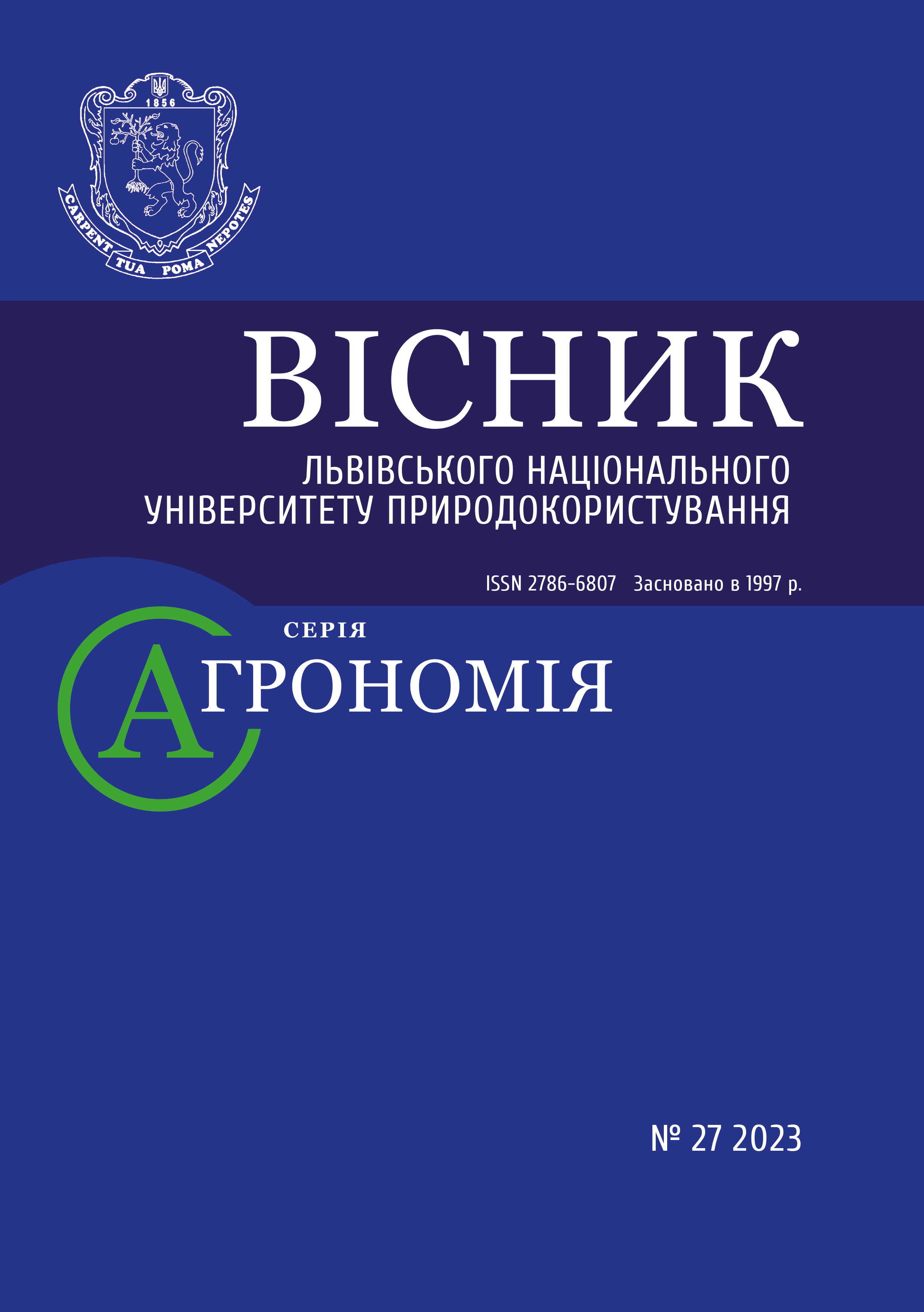Результати виведення селекційно-цінних гібридів картоплі методом ступінчастої міжсортової гібридизації
DOI:
https://doi.org/10.31734/agronomy2023.27.121Ключові слова:
картопля, селекція, ступінчаста гібридизація, міжсортові гібриди, відбір, селекційно-цінні ознакиАнотація
З метою реалізації програм з прикладної селекції картоплі у Львівському НУП під час
створення вихідного селекційного матеріалу проводять ступінчасті міжсортові схрещування,
ідеологія яких полягає у поєднанні в одному генотипі комплексу цінних господарських
ознак, які притаманні вихідним батьківським формам.
У результаті міжсортової ступінчастої гібридизації у ЛНУП створено низку нових
гібридних форм картоплі різного походження та строків дозрівання. Вихідними
батьківськими формами для гібридизації слугували сорти картоплі української селекції:
Бородянська рожева, Водограй, Гібридна 14, Воля, Західна, Зов, Ліщина, Львів’янка,
Оксамит, Повінь, Світанок київський та іноземні сорти: Nevskа, Suzorye, Aminca, Sante,
hybrid SVP.
Завдання досліджень полягало в тому, щоб дати комплексну оцінку перспективним
міжсортовим гібридам картоплі за цінними господарсько-біологічними ознаками, щоб
найкращі форми рекомендувати як кандидати у нові сорти.
Дослідження проводили протягом 2020–2022 рр. Для досліджень використовували
дев’ять нових гібридів картоплі різних груп стиглості. Кожен із гібридів та відповідних
стандартних сортів картоплі висаджували на ділянках із площею живлення рослин 70×35 см,
що становило 40,8 тис. рослин на 1 га. Експериментальні ділянки були розміщені у трьох
повтореннях, із використанням систематичного методу. Облікова площа ділянки – 25 м 2 .
Стандартами слугували сорти картоплі вітчизняної селекції: для середньоранньої групи –
Водограй, середньостиглої – Воля, та середньопізніх – Західна.
Встановлено, що ступінчаста міжсортова гібридизація дозволяє поєднати потенційно
високу продуктивність (1000 г/кущ і вище), інтенсивне формування врожаю з підвищеним
умістом крохмалю в бульбах (16–18 %) і високу стійкість до фітофторозу (на рівні 7–8 балів).
На основі проведених досліджень з комплексної оцінки господарських і біологічних
ознак нових міжсортових гібридів картоплі виділено й відібрано середньоранній гібрид
02/10-40 (Бородянська рожева × Сузор’є), середньостиглий 11/4-1 (Західна × Водограй) і
середньопізній 16/17-1[(Західна × Sante) × (Воля × Ліщина)], які істотно переважають за
комплексом господарсько-цінних ознак відповідні сорти-стандарти. Зауважено доцільність
продовжити з ними подальшу селекційну роботу відповідно до прийнятої схеми селекції
картоплі, інтенсивно розмножувати й готувати для передачі у Державне сортовипробування
як кандидатів у нові сорти цієї культури.
Посилання
Basics of scientific research in achronology. Edited by V. O. Yeshchenko, Doctor of Agricultural Sciences. Kyiv-Diya, 2005. 286 p.
FAO: FAO Production Yearbook. Food and Agricultural Organization. United Nations Rome, 2014.
Food and Agriculture Organization of the United Nations, FAOSTAT. URL: http://www.fao.org. (Accessed August 25, 2023).
Honcharov M. D. Selection of potatoes for early maturity. Potato. Bila Tserkva. 2002. Vol. 1. P. 226–242.
Ilchuk L. A., Ilchuk R. V. Variety as a factor influencing the productivity and quality of potatoes. Foothill and mountain agriculture and animal husbandry. Lviv, 2002. Vol. 44. P. 37–44.
Kozhushko N. S., Dubovik V. I. Prospects for the development of potato growing. Bulletin of SNAU. Sumy. 2005. Vol. 12. P. 5–7.
Manolov I., Neshev N., Chalova V. Tuber Quality Parameters of Potato Varieties Depend on Potassium Fertilizer Rate and Source. Agriculture and Agricultural Science Procedia. 2016. Vol. 10. P. 63–66.
Methodological recommendations for conducting research with potatoes. Nemishaeve, 2002. 184 p.
Muzyka I. M. The use of stepwise intervarietal hybridization to create potato source material with selection-valuable characteristics. International Student Scientific Forum, October 4–6, 2022. Lviv, 2022. P. 76.
Osypchuk A. A. Current issues of potato selection. Potato farming. 2004. Vol. 33. Kyiv: Urozhai, 2004. P. 27–32.
Osypchuk A. A. Potato breeding at the beginning of the 21st century. Potato production of Ukraine. 2005. No 1. P. 7–8.
Osypchuk A. A. Results and tasks of potato breeding in Ukraine. Potato farming. 2002. No 31. P. 15–20.
Shelepov V. V. et a. The variety and its value in increasing productivity. Varietal testing and protection of rights to plant varieties. Kyiv: Alefa, 2006. P. 140–144.
Sihariova D., Chabanov A., Taktaiev B. The role of resistant varieties in the protection of potatoes. Agrarian week. 2014. No 14. P. 32–33.
Taran S. Factors of the pathological process and formation of the causative agent of late blight of potatoes. Potato planter. 2003. No 1. P. 18–19.
Zaviriukha P. Potato breeding at Lviv Agricultural University: history and results. Bulletin of LNAU: agronomy. 2018. No 22. T. 1. P. 63–79.
Zaviriukha P. D. Potato breeding at Lviv NAU: results and prospects. Innovative development of agro-industrial complex: problems and their solutions. Zhytomyr: Zhnaeu, 2015. P. 45–50.
Zaviriukha P., Kokhanets O., Kosylovych H. Disease-resistant varieties as the basis of ecological potato growing. Bulletin of Lviv NAU: agronomy. 2013. No 17 (2). P. 208–215.
Zaviriukha P. D., Muzyka M. M. Results of creation of intervarietal hybrids of potatoes with a complex of economic and valuable traits. In the collection: Agrarian education and science: achievements and development prospects. Bila Tserkva, 2022. P. 37–40.
Zaviriukha P. D., Muzyka M. M. Selection of potato hybrids with intensive crop formation and other valuable economic traits. In the collection: Young science in Volyn: research priorities and perspectives. Lutsk, 2022. P. 62–65.
Zholudenko O. V. Phytophthora of potatoes. Protection of plants. 2011. No 10. P. 22–24.


